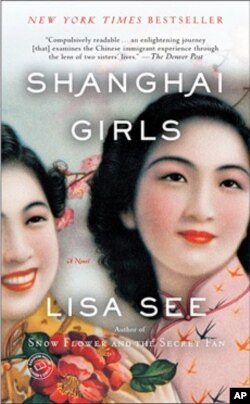In her novel Shanghai Girls, author Lisa See takes readers on a turbulent journey from China torn by war in the 1930s to Los Angeles' Chinatown.
Shanghai Girls is a story of two sisters, and it opens Shanghai in 1937. The city was a glamorous international center, known as the Paris of Asia. But according to Lisa See, that life was about to change for sisters May and Pearl.
"It was a final, final moment before things took a real change. In August of 1937, the Japanese invaded," See said. "The Sino-Japanese War rolled right into World War II. As soon as World War II was over, civil war [erupted]. And then in 1949, Mao [Zedong] and the communists took over the country. And so Shanghai went from being kind of like the Paris of Asia to being for many, many years a very dark, very gray, very grim place."
Much later, Shanghai would experience a renaissance, but that is beyond the time frame of this story. See traces the journey of the sisters, beginning with their life of comfort.
"They are what were called 'beautiful girls. They are models for Shanghai advertising. And they think they are going to have one kind of life, this kind of glamorous, beautiful, fun life and then several things happen, one of which was that the Japanese invade. Their father also loses all of their money, and they suddenly find themselves in arranged marriages on their way to the United States," See said.
Like most who arrived on the U.S. West Coast, they went through Angel Island off the California coast, where inspectors intensely questioned the hopeful immigrants.
The inspectors were looking for so-called "paper sons" – those who had bought false documents to indicate they were the children of U.S. citizens – and also for "paper merchants," those who had paid a Chinese-American business owner to create a fictitious partnership. Wives and fiancées of Chinese-American citizens were also often suspected of fraud.
Pearl and May settle in humble quarters in Los Angeles' Chinatown with their new extended family. They undergo ups and downs in their business and family lives, and face continued scrutiny from immigration officials.
The story recounts the fears of communist infiltration of the United States in the 1950s, after the communist victory in the Chinese civil war. Late in the decade, some who had entered the country illegally were granted amnesty.
But as See points out, this often was at the cost of informing on friends or family members who were illegal immigrants or were accused of being communist sympathizers.
"So this was something that ripped apart communities, families, businesses and it is something that even today, people do not want to talk about it because they still have so much shame and embarrassment and guilt about what happened back in those days," See adds.
Shanghai Girls examines a part of the immigrant experience that most Americans share. Although these immigrants were from China, See points out that similar stories can be told of those from other places.
"We all have someone in our family who was scared enough, crazy enough, brave enough to leave their home country, be expelled from their own country to come here," said See. "We all share in that. And so the experience itself, I believe, is a uniquely American experience, but then there are these moments when something might be unique to the Chinese-American experience."
Like several of See's earlier novels, Shanghai Girls explores the emotional ties between women. The author says this story looks at the bond between sisters, who are best friends and rivals.
"Your sister is someone who has known you from birth, who should stand by you and love you and support you, no matter what. But you know, it is also your sister who knows exactly where to drive the knife to hurt you the most, and you know where to drive the knife to get her back," See said.
But she says the bond between sisters, like those in her story, is one of the strongest.
Lisa See looks Western – with red hair and freckles. But she is one-eighth Chinese, and she grew up with close ties to Los Angeles' Chinatown, where her great-grandfather was an early resident and a business owner.
All of See's books, fiction and non-fiction, relate to China or the Chinese-American immigrant experience. She says her next book will continue the story of Shanghai Girls when the present novel ends in 1957. It will focus on China's disastrous experiment known as the Great Leap Forward, the communist government's drive to industrialize and abolish private farming. The program created widespread famine and resulted in millions of deaths. See says the little-understood part of China's history affected families on both sides of the Pacific.











